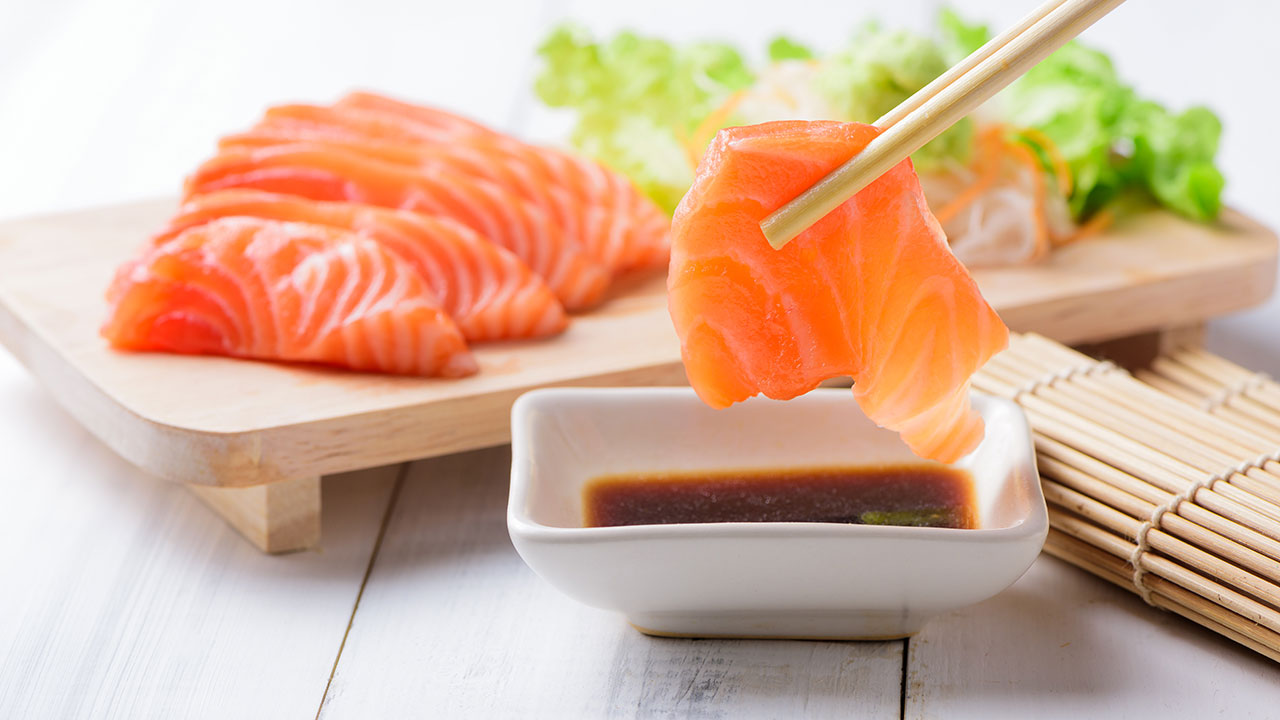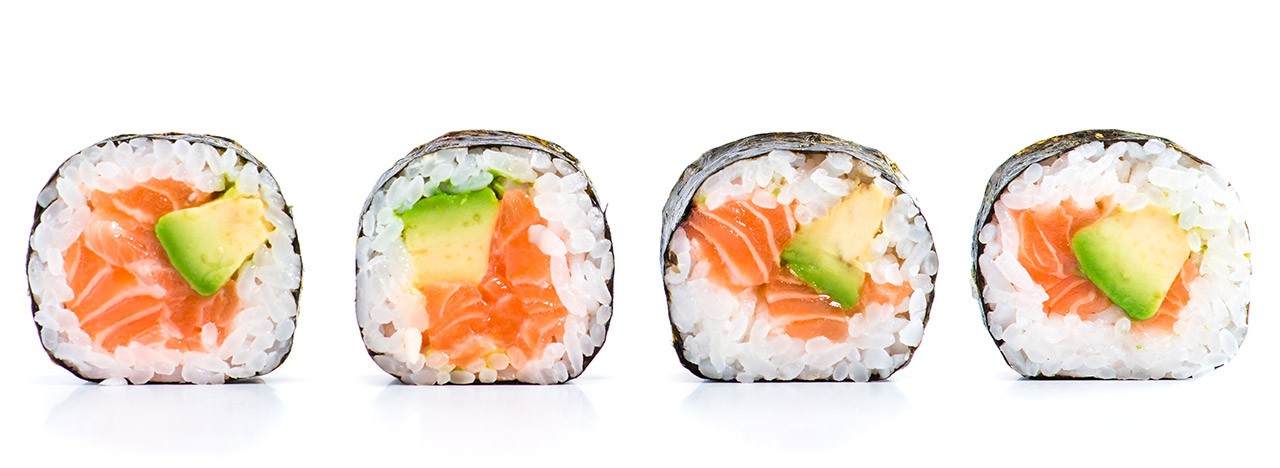Follow us 261.1k
Quick Summary tl;dr
Traditional sushi revolves around vinegar-seasoned rice combined with fillings, primarily seafood. There's Nigiri, Sashimi, Maki, and more.
Rice, a sushi staple, is packed with carbs, which are a no-go for keto diets. Arsenic in rice is a health concern, with inorganic arsenic linked to health issues.
There's an array of rice-free sushi alternatives. Options include pure sashimi, cauliflower rice sushi, and nori-wrapped protein rolls, among others.
Filling choices for low-carb sushi are vast, from fatty tuna sashimi and bell peppers to grilled meats and eggs.
Resistant starch in rice can promote gut health but doesn't make rice keto-friendly. Its carb content remains high.
When dining out, opt for sashimi or sushi without rice. Freshness is key for homemade sushi, especially with raw fish. And for safety, use "sushi-grade" fish.
Sushi, a culinary treasure that hails from Japan, has captured hearts worldwide. But for those committed to a low-carb or keto lifestyle, the rice integral to traditional sushi presents a challenge. Enter rice-free alternatives: your passport to enjoying sushi without the carb-laden guilt!
Understanding Traditional Sushi
Sushi, often misconceived as just raw fish, is a symphony of meticulously balanced flavors and textures. The heart of sushi is its vinegar-seasoned rice, which boasts a unique combination of sweetness, saltiness, and tang. This rice forms the canvas upon which a plethora of ingredients can be showcased, from fresh fish and savory vegetables to rich condiments and delicate garnishes.
The origin of sushi can be traced back to ancient Southeast Asia, where fish was fermented with rice and salt. As sushi evolved, particularly in Japan, the fermentation process was eliminated, but the pairing of fish and rice persisted.
Today, sushi comes in various forms:
- Nigiri: Hand-pressed mounds of rice topped with a slice of fish, seafood, or other toppings.
- Maki: Rolled sushi, where fillings are enveloped in rice and wrapped with a nori (seaweed) sheet. This category can be further divided into:
- Hosomaki: Thin rolls with the rice on the inside and the nori on the outside.
- Uramaki: Also known as inside-out rolls, where the rice is on the outside and the nori is on the inside.
- Futomaki: Thick rolls filled with multiple ingredients.
- Sashimi: Although not technically sushi since it doesn't include rice, sashimi features thin slices of fresh fish or seafood, served without any accompaniments.
- Temaki: Hand rolls. These are cone-shaped pieces with the nori on the outside and the ingredients spilling out of the wide end.
- Chirashi: Translates to "scattered sushi." It's a bowl of sushi rice topped with a variety of sashimi and other ingredients.
- Inari Sushi: A pouch of fried tofu filled with sushi rice. It's named after the Shinto god Inari, who had a fondness for tofu.
- Oshi Sushi: Also known as pressed sushi, it's made by pressing fish onto rice in a wooden mold.
- Gunkan Maki: Translates to "battleship roll." It's a small oval mound of sushi rice wrapped with a thin strip of nori and topped with soft or loose ingredients that wouldn't otherwise hold to the rice, like roe or sea urchin.
Each form offers a unique experience in taste and presentation, catering to a variety of preferences and occasions. Some are ideal for a quick snack, while others might grace the table at a more formal sushi dining experience.
The Role of Rice in Sushi
The art of sushi-making, or "sushi craft," as some chefs refer to it, takes years to master. It isn’t just about combining ingredients but understanding the delicate balance between them, ensuring that no single element overshadows another.
In essence, while the seafood often takes center stage in sushi, the unsung hero remains the rice. Its sticky consistency holds the sushi together, its mild flavor profile accentuates the freshness of the seafood, and its temperature (slightly warm) contrasts beautifully with the cool toppings.
Why Rice is a No-Go for Low-Carb and Keto Enthusiasts
Rice, a staple in many cuisines worldwide, is a significant source of carbohydrates. While it serves as an excellent energy provider for most people, its high carb content poses challenges for those following keto or low-carb diets.
Carbohydrate Content
A single serving of sushi rice can contain anywhere from 20 to 40 grams of carbohydrates. When you factor in the cumulative carb content from multiple sushi pieces, the numbers can quickly add up, pushing daily carb intake beyond recommended limits for low-carb dieters.
Hindrance to Ketosis
The ketogenic diet focuses on shifting the body's primary energy source from carbohydrates to fats. For this metabolic state, termed ketosis, to kick in, one needs to limit their daily carb intake significantly. The carbohydrates in sushi rice can disrupt this delicate balance, potentially knocking someone out of ketosis.
Blood Sugar Levels
Carbohydrates get converted into glucose in the body, causing a rise in blood sugar levels. For individuals who are insulin resistant or watching their blood sugar levels, a sudden spike from consuming sushi rice can be problematic.
Digestion and Satiety
While rice does provide a feeling of fullness, it might not keep one satiated as long as high-fat or high-protein foods, which are cornerstones of the keto and many low-carb diets. This could lead to increased hunger pangs or snacking tendencies.
Nutritional Balance
While rice does offer certain essential nutrients like B vitamins, it lacks the dense micronutrient profile found in many low-carb foods such as leafy greens, avocados, or fatty fish. Hence, frequent consumption of sushi rice might divert one from achieving an optimal nutrient balance.
In conclusion, while sushi rice is delicious and culturally significant, its high carbohydrate content and subsequent effects on metabolism make it a less-than-ideal choice for those adhering to strict low-carb or keto diets.
Is Arsenic in Rice a Concern?
Rice can contain inorganic arsenic, a toxin linked to health problems. Arsenic finds its way into rice due to both natural conditions and the aftermath of certain agricultural practices. Concerns about inorganic arsenic in rice have been highlighted by health organizations such as the U.S. Food and Drug Administration (FDA) and the World Health Organization (WHO).
While occasional rice consumption might not pose a significant risk, those who eat rice frequently might want to diversify their grains or consider varieties that tend to have lower arsenic content, like basmati rice from certain regions. It's also recommended to rinse rice thoroughly and use a cooking method that allows excess water to be poured off, which can reduce the arsenic content.
It's worth noting that not all rice contains the same levels of arsenic. Factors like rice variety, geographic region where it's grown, and cooking methods can influence its arsenic content. If you're concerned about arsenic, it's a good idea to stay informed about the latest research and recommendations on rice consumption.

Exploring Rice-Free Sushi Alternatives
1. Sashimi
Sashimi is all about showcasing raw fish without rice. It's essential to go for sushi-grade fish like tuna, salmon, or mackerel to ensure safety and best taste. For dipping, there's the usual soy sauce, but for those avoiding gluten, tamari or coconut aminos are good picks. Round off with wasabi and pickled ginger.
2. Cauliflower Rice Sushi
Cauliflower, when processed into grain-like bits, offers a texture that mirrors rice. After getting it to the right consistency, season as you'd do with regular sushi rice. To get that sushi-like stickiness, it's key to mix in some cream cheese or Sugar-Free Mayonnaise for those avoiding dairy.
Pro tip: To circumvent the distinctive cauliflower flavor, boil it briefly. Post-cooking, drain, let it cool, and using a nut milk bag or cheesecloth, expel any lingering moisture.
Recipes to try:
3. Palmini Rice Sushi
Palmini rice is another alternative. Out of the can, it might taste a tad sour for some, reminescent of pickled artichokes. To neutralize this, a quick boil, drain, and cooling session is recommended before assembling your sushi.
Buy Palmini Rice on: Amazon US, Amazon UK
4. Shirataki Rice Sushi
Shirataki rice is ultra-low in carbs and offers a unique texture. For that sticky sushi feel, mix in some cream cheese or mayo. And for added nutrition, you might want to mix in some cauliflower or palmini rice.
Buy Shirataki Rice on: Amazon US, Amazon UK
5. Nori Wrapped Protein Rolls
Here, we skip rice and wrap fillings directly in nori sheets. Think fillings like thin sashimi slices, smoked salmon, or fresh veggies. For a creamy touch that also helps keep things together, mashed avocado or cream cheese is a winner.
Recipes to try:
6. Cucumber Wrapped Sushi
Thin cucumber slices serve as a refreshing wrap for sushi fillings. For evenly thin slices, use a vegetable peeler. This crunchy alternative is refreshing and light. A touch of mashed avocado in the filling makes it all gel together nicely.
Recipe to try:
- Salmon Mousse Cucumber Rolls - although not traditional sushi recipe, it's a good example of how you can use thinly sliced cucumber to make sushi.
7. Smoked Salmon Sushi
Thinly sliced smoked salmon can be both wrap and star of the show when making rice-less sushi! It's flavorful and holds other fillings well.
Recipe to try:
8. Egg Wraps & Japanese Style Omelets
Create thin omelet sheets or use traditional Japanese Tamago (sweetened with a low-carb sweetener) as a base. These egg wraps are not only delicious but add a protein punch as well as satiety factor to your sushi.
Recipe to try:
Choosing the Right Fillings for Low-Carb Sushi
Sushi isn't just about the rice; the fillings play a starring role too. When venturing into the realm of low-carb sushi, it's crucial to pick ingredients that are keto-friendly and align with your dietary goals.

Here's a deeper dive into how you can expand your sushi filling repertoire:
Fish & Seafood
- Tuna: Fatty tuna, or toro (the fatty part of the tuna's belly), is a sushi favorite as well as leaner akami.
- Salmon: Rich in Omega-3s, salmon can be used fresh or smoked.
- Shrimp: Either grilled or boiled, shrimp adds a nice bite.
- Crab: Real crab meat or even imitation crab (though check carb content) can be used.
- Eel: Grilled eel or unagi is a flavorful, albeit slightly sweet option. You can always make your own by using our Sugar-Free Teriyaki Sauce which is not exactly the same sauce as the one used to make unagi but it will be close.
- Other fish & seafood such as octopus, mackerel, salmon roes (high in Lyso-DHA), sea urchin, and more.
Meats
- Beef: Thinly sliced grilled beef or even steak bits can give sushi a new twist.
- Chicken: Grilled or smoked chicken, especially when paired with spicy mayo or avocado, is a treat.
- Pork: Think thin slices of grilled pork belly for a richer sushi experience.
Vegetables
- Avocado: Creamy and rich, avocados are a low-carb staple and sushi favorite.
- Bell Peppers: For a crunch, consider thin strips of bell peppers in varied colors.
- Cucumber: Fresh and hydrating, cucumbers add a lovely crunch.
- Daikon Radish: A classic spiralized daikon radish should not be omitted from your sushi meal!
- Asparagus: Lightly grilled or steamed, asparagus brings a unique flavor.
- Green onions: A sprinkle of chopped green onions can add a zesty punch.
Dairy & Eggs
- Cream Cheese: This dairy favorite adds a rich creaminess that complements many sushi ingredients.
- Cheese Slices: Mild cheeses like Swiss or mozzarella can be cut into thin strips for a unique sushi experience.
- Eggs: Consider fluffy scrambled eggs or thinly sliced omelets. Japanese Tamago, a sweetened omelet, is also a traditional sushi filling.
Additional Flavor Enhancers
- Mayo Mixes: Mix mayonnaise with a touch of hot sauce or sriracha for a spicy kick.
- Sesame Seeds: A sprinkle of roasted sesame seeds can elevate the flavor profile.
- Pickled Radish: Adds a tangy crunch to your sushi. You can make your own Pickled Radishes at home!
- Pickled Ginger: You can even whip up Sugar-Free Pickled Ginger at home!
Experimenting is key. Try different combinations to discover which flavors and textures you enjoy most. Remember, the beauty of making sushi at home is tailoring it to your exact preferences.
Is Rice with Resistant Starch Low-Carb?
Resistant starch has been making waves in the nutrition world, and with good reason. Unlike typical starches, resistant starch isn't fully broken down and absorbed in the small intestine. Instead, it travels to the large intestine where it serves as food for beneficial gut bacteria, promoting gut health and potentially aiding in weight management.
Rice, when subjected to certain cooking and cooling methods, can increase its resistant starch content. Here's how it works:
- The Cooling Process: After cooking rice, letting it cool for several hours or overnight can transform some of its digestible starches into resistant starch. This process is called retrogradation.
- Reheating: Interestingly, reheating the cooled rice doesn't significantly decrease its resistant starch levels. So, it's possible to enjoy it warm without losing the benefits.
However, there are crucial points to consider for those on a low-carb diet:
Not Entirely Low-Carb
While resistant starch can lower the amount of digestible carbs, the overall carb content in rice remains significant. This means that even rice high in resistant starch can still be pretty high in total/net carbs.
Though resistant starch has a lesser impact on blood sugar compared to other starches, rice can still elevate blood sugar levels, especially in large amounts.
If you're considering incorporating resistant starch-rich rice into a low-carb diet, portion control becomes paramount. Small amounts might fit within daily carb limits, but it's essential to monitor individual responses.
In summary, while rice with increased resistant starch content offers potential health benefits, it doesn't transform rice into a low-carb food. For those strictly following keto, it's best approached with caution.

FAQs (Frequently Asked Questions)
Can I eat sushi out at a restaurant on a low-carb diet?
Definitely! Choose sashimi or request sushi without rice. Many restaurants nowadays have cucumber-wrapped roll options.
How long can I store my low-carb sushi?
It's best to eat it within a day to ensure freshness. If you're using raw fish, it's advisable to consume it right away.
Can I use frozen fish for my sashimi?
Yes, you can. Just make sure it's specifically labeled as "sushi-grade" to ensure safety.
Is wasabi low-carb?
Yes, wasabi is generally low in carbs. However, some commercial varieties might have added sugars, so always check the label.
What about soy sauce? Is it low-carb?
Traditional soy sauce is low in carbs and can be included in a low-carb diet. But if you're avoiding gluten or soy, you can opt for alternatives like tamari (gluten-free) or coconut aminos.
Can I use any vegetables for my sushi fillings?
While most vegetables typically used in sushi are low in carbs, it's best to stick to options like cucumber, avocado, and bell peppers. Other higher-carb options like carrots can be used in moderation.
How can I make my cauliflower rice more sticky, like sushi rice?
Mixing in a bit of cream cheese or mayo can help give cauliflower rice a stickier consistency, making it easier to roll.
Is pickled ginger low-carb?
Traditional pickled ginger often contains sugar. Look for sugar-free versions or consider making your own at home.
I miss the sweetness of sushi rice. Any healthy solutions?
You can achieve a similar sweetness by adding a sugar-free sweetener, like Allulose or stevia, to your cauliflower or alternative rice. Just a touch will do!
Conclusion
Embracing low-carb sushi isn't just about dietary restrictions; it's about discovering a world of delicious and inventive alternatives. As you dive into this culinary journey, you'll find the joy of enjoying sushi's essence without the extra carbs.
Crafting the perfect rice-free sushi roll might require a few tries, but the journey is part of the fun. A few tips to get you started: make sure your fillings aren't too wet to avoid a mushy roll, invest in a quality bamboo mat for that flawless roll, and don't forget to play around with low-carb sauces and seasonings to bring out the best in every bite.
Do you like this post? Share it with your friends!
Let us know what you think, rate this post!
